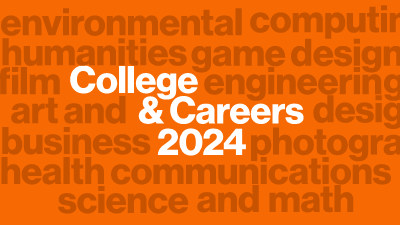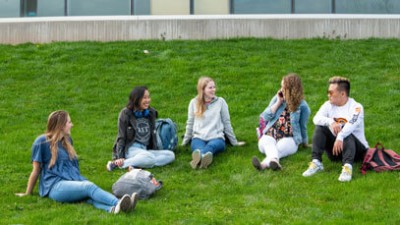Fine Arts Studio Master of Fine Arts Degree


Fine Arts Studio
Master of Fine Arts Degree
- RIT /
- Rochester Institute of Technology /
- Academics /
- Fine Arts Studio MFA
Request Info about graduate study
Visit
Apply
School of Art
This master’s in fine arts explores the role of contemporary art through painting, printmaking, sculpture, and expanded forms.
Overview for Fine Arts Studio MFA
The MFA in fine arts studio is committed to collaboration and interdisciplinary approaches both within the four major fine arts areas of study (painting, printmaking, sculpture, or expanded forms) and the entire College of Art and Design.
What is Fine Arts?
Fine arts refers to creating artwork through painting, sculpture, printmaking, illustration, expanded forms, and other visual arts. Those earning an MFA in fine arts work as artists, art educators, art instructors, curators, gallery directors, archivists, or administrators of arts and cultural institutions.
RIT’s Master’s in Fine Arts
The MFA in fine arts studio is a rigorous two-year program comprised of major studio courses; studio electives such as glass, ceramics, film, and photography; theory and research seminars; as well as thesis credits. The program’s structure allows for personal growth, experimentation, collaboration, and unique, non-discipline-specific results to occur in the thesis, which is a public exhibition of the student's work. Courses are meant to concentrate on creative visual work while also thinking about making and sustaining a dialogue.
Join us for Fall 2024
Many programs accept applications on a rolling, space-available basis.
30% Tuition Scholarship for NY Residents and Graduates
Now is the perfect time to earn your Master’s degree. If you’re a New York state resident with a bachelor’s degree or have/will graduate from a college or university in New York state, you are eligible to receive a 30% tuition scholarship.
Careers and Experiential Learning
Typical Job Titles
| Art Teacher | Fine Artist |
| Assistant Archivist | Gallery Director |
| Mural Artist | Studio Artist |
Cooperative Education and Internships
What makes an RIT education exceptional? It’s the ability to complete relevant, hands-on career experience. At the graduate level, and paired with an advanced degree, cooperative education and internships give you the unparalleled credentials that truly set you apart. Learn more about graduate co-op and how it provides you with the career experience employers look for in their next top hires.
Co-ops and internships take your knowledge and turn it into know-how. Your art and design co-ops will provide hands-on experience that enables you to apply your artistic capabilities in dynamic professional settings while you make valuable connections between classwork and real-world applications.
Cooperative education, internships, and other experiential learning opportunities are strongly encouraged for graduate students in the MFA in fine arts studio.
Creative Industry Days
Connect with Design Industry Leaders
RIT’s Office of Career Services and Cooperative Education hosts Creative Industry Days, which connects students majoring in art, design, film and animation, photography, and select computing majors with companies, organizations, creative agencies, design firms, and more. Creative Industry Days are a series of events that allow you to network with company representatives and interview directly for open co-op and full-time employment positions.
Featured Work
Painting the Natural World
Emily Glass
A collection of paintings created by undergraduate and graduate students in Painting the Natural World classes taught by RIT School of Art Senior Lecturer Emily Glass. The course examines the natural...
Renowned Printmaker
Eileen Bushnell
Professor Eileen Feeney Bushnell was awarded Best in Show at Print Club of Rochester's 90th annual Member Exhibition in 2021 for her printmaking work, "The 60th Year" (Intaglio, Monoprint...
'Connections'
Kerina Mangiaracina
"In my life as a child, wife, mother and artist, the issues related to relationships and connections to others have defined the parameters of my journey. Bonds that link or separate us, desire,...
Featured Profiles
Ink Innovation: Blending Art and Engineering in Textile Antenna Technology
Eileen Bushnell
Dylan Bennish ’24 BS, MS (electrical engineering) blends art with engineering to screen print textile antennas capable of tracking glucose levels in cheap, less invasive ways than current methods.
Embracing creativity and exploration
Alex Lobos, Gregory Halpern, Elizabeth Kronfield, Todd Jokl
The College of Art and Design at RIT offers distinctive graduate degrees that combine the best of art, design, creativity and technology. Our diverse portfolio of graduate program offerings includes...
Class of 2021 Reflections
College of Art and Design Class of 2021 graduates share their favorite RIT memories and offer inspirational words for their peers.
Curriculum Update in Process for 2024-2025 for Fine Arts Studio MFA
Current Students: See Curriculum Requirements
Fine Arts Studio, MFA degree, typical course sequence
| Course | Sem. Cr. Hrs. | |
|---|---|---|
| First Year | ||
| STAR-701 | Technology in the Studio This course will introduce a contemporary technology used by the course instructor in their studio practice. Students will be encouraged to investigate how this technology may be applied in their making process. The subjects offered in the course will vary according to the faculty teaching the class. The course can be taken multiple times with faculty permission. (This course is available to RIT degree-seeking graduate students.) Studio 6 (Fall or Spring). |
3 |
| STAR-702 | Studio Art Research This course will prepare graduate students for the written component of the thesis. Course content will cover defining research in the arts, arts based research, research through practice, critical judgment, writing strategically and critically for reflective thinking and scholarly dissemination. At the completion of this course students will be able to write a thesis proposal addressing a research question or direction along with objectives, context, and methods. (Prerequisites: STAR-701 or equivalent course.) Lecture 3 (Spring). |
3 |
| STAR-714 | Ideation and Series Creative flow, having an endless stream of ideas, alternatives, and choices for solutions, helps creative work evolve and reach more advanced levels. In this course students develop appropriate skills and strategies to generate ideas and develop them effectively into a cohesive body of work. (Prerequisites: This course is restricted to students in the FNAS-MFA or GLASS-MFA
or METAL-MFA or CCER-MFA or WOOD-MFA programs.) Studio 6 (Fall). |
3 |
Major Studio Courses* |
12 | |
Open Electives |
6 | |
Professional Elective |
3 | |
| Second Year | ||
| STAR-706 | Business Practices for Studio Artists This class is devoted to business issues that artists must address including portfolio management, pricing and marketing strategies, and public relations for pursuit of a professional career as studio artists. Financial and communication skills are highlighted as are networking skills for the advancement of an artist’s work. (Prerequisites: This course is restricted to students in the FNAS-MFA or GLASS-MFA
or METAL-MFA or CCER-MFA or WOOD-MFA programs.) Lecture 3 (Spring). |
3 |
| STAR-718 | Research Methods and Publication Students will conduct research appropriate for individual thesis directions, incorporate that research into writing, analyze and review their thesis body of work then produce and publish their written thesis document. (Prerequisites: STAR-702 or equivalent course.) Lecture 3 (Spring). |
3 |
| STAR-790 | Research and Thesis This is the first of two courses designed to advance a student towards completion of their thesis. Students will work independently on their approved proposal while meeting on a regular basis with their committee chair. Students are required to meet at least twice with their full committee during the semester. (Prerequisites: STAR-702 or equivalent course.) Thesis (Fall). |
3 |
| STAR-890 | Thesis For this final thesis course students continue working with their committee to evaluate work produced, and select the work to be exhibited. In addition, students will work with gallery coordinators and curators to install and exhibit their final body of work. Students are expected to defend their work to the committee through an oral defense and a written document. (Prerequisite: STAR-790 or equivalent course.) Thesis (Spring). |
6 |
Major Studio Courses* |
12 | |
Open Elective |
3 | |
| Total Semester Credit Hours | 60 |
|
* Students may choose any combination of the following major studio courses: Painting (PAIT-601), Printmaking (PRNT-601), Sculpture (SCUL-601), or Expanded Forms (SCUL-611).
Professional Electives
| Course | |
|---|---|
| ARTH-600+ | Any ARTH 600 level course or above This course explores the history of contemporary art and visual culture from postmodernism to the present. We will focus on major artistic movements such as Pop Art, Minimalism, Conceptualism, Performance Art, and Relational Aesthetics. Along with and inseparable from aesthetics and media, we will chart the ways in which class, gender, race, and sexual inequality have figured into the major aesthetic movements of our time. By reading theory and criticism, discussing artworks across media forms, and researching artistic movements in context, students will examine art since the 1960s and its connections to cultural history. Graduate students will complete a research project and class presentation in addition to the writing assignments and discussion expected in the undergraduate section. Lecture 3 (Spring). |
| IDEA-705 | Thinking About Making: The Practice of Art in a Global Society The course seeks to bridge the gap between studio practice and contemporary art history. Course content will explore current work and ask questions about what is art, who is the audience, what is “our” art making practice, and how does that fit within the larger context of the current state of the global art world. How do we measure success and artistic failure? The course emphasizes observation, critical analysis, and written interpretation. Lecture 3 (Fall, Spring). |
| IDEA-776 | College Teaching and Learning This course will provide students with an introduction to the scholarship of teaching and learning in the university environment. Students will explore a range of perspectives on pedagogical practice, curriculum development and the assessment of learning in a studio, lab and seminar based classroom. Additionally, students will focus on ways that students learn, how learning can be improved, and different methods of conducting research into teaching and learning. Students are expected to write critical papers and essays, develop curriculum resources, and to participate in weekly small and large format discussion groups. Online technology is utilized in addition to lectures, videos, and other forms of media. (This course is restricted to CAD degree-seeking graduate students.) Lecture 3 (Fall). |
| STAR-635 | Curating and Managing Art Spaces This course explores the roles of contemporary, traditional, and alternative art spaces through curatorial studies, exhibition evaluation and criticism. Student will consider gallery administration roles and supporting operations, and undertake site visitations and gallery research. Students will organize and install a final exhibition project in an approved exhibition venue. (This class is restricted to degree-seeking graduate students or those with permission from instructor.) Lecture 3 (Fall). |
| STAR-645 | Art Exhibition Critique This course will explore the role of the art exhibition and its effect on the discourse and practice of art. Course content will focus on: contemporary and historical exhibition studies, individual and group projects. Student will also conduct site visitations and evaluation, and critique work in the context of exhibition. (This class is restricted to degree-seeking graduate students or those with permission from instructor.) Lecture 3 (Fall). |
| STAR-758 | Studio Art Critique Students will explore the process of critical analysis of studio work. Content will focus on the structure and form of the critique process. They will discuss, defend, and interpret existing studio work as they work towards their thesis. Faculty led critiques will include studio visits for in depth analysis of works in progress. (Prerequisites: This course is restricted to students in the FNAS-MFA or GLASS-MFA
or METAL-MFA or CCER-MFA or WOOD-MFA programs.) Lecture 3 (Fall, Spring). |
Admissions and Financial Aid
This program is available on-campus only.
| Offered | Admit Term(s) | Application Deadline | STEM Designated |
|---|---|---|---|
| Full‑time | Fall | February 1 priority deadline, rolling thereafter | No |
Full-time study is 9+ semester credit hours. International students requiring a visa to study at the RIT Rochester campus must study full‑time.
Application Details
To be considered for admission to the Fine Arts Studio MFA program, candidates must fulfill the following requirements:
- Complete an online graduate application.
- Submit copies of official transcript(s) (in English) of all previously completed undergraduate and graduate course work, including any transfer credit earned.
- Hold a baccalaureate degree (or US equivalent) from an accredited university or college.
- A recommended minimum cumulative GPA of 3.0 (or equivalent).
- Submit a current resume or curriculum vitae.
- Submit a personal statement of educational objectives.
- Submit two letters of recommendation.
- Entrance exam requirements: None
- Submit a portfolio. View portfolio requirements.
- Writing samples are optional.
- Submit English language test scores (TOEFL, IELTS, PTE Academic), if required. Details are below.
English Language Test Scores
International applicants whose native language is not English must submit one of the following official English language test scores. Some international applicants may be considered for an English test requirement waiver.
| TOEFL | IELTS | PTE Academic |
|---|---|---|
| 79 | 6.5 | 56 |
International students below the minimum requirement may be considered for conditional admission. Each program requires balanced sub-scores when determining an applicant’s need for additional English language courses.
How to Apply Start or Manage Your Application
Cost and Financial Aid
An RIT graduate degree is an investment with lifelong returns. Graduate tuition varies by degree, the number of credits taken per semester, and delivery method. View the general cost of attendance or estimate the cost of your graduate degree.
A combination of sources can help fund your graduate degree. Learn how to fund your degree
Latest News
-
March 21, 2024
![A student binds a book in the textile makerspace in the SHED.]()
Innovation unleashed: students forge transdisciplinary projects at RIT's a2ru summit
Students leveraged the variety of makerspaces in RIT's brand-new SHED facility to create arts-integrative work responding to a theme of "Play."
-
August 30, 2023
![Wall signage with College of Art and Design in big, silver letters.]()
New School of Design director, faculty hires ready for 2023-24 academic year
The College of Art and Design welcomes new hires to its faculty roster while longtime faculty Alex Lobos assumes a role as director of the School of Design.
-
June 6, 2023
![A green teapot with saffron outlines.]()
Students leverage creativity to give back to Rochester community
RIT students created artworks to benefit Keeping Our Promise, a local nonprofit that provides resettlement assistance for Afghan, Iraqi and Kurdish interpreters and support personnel who served U.S. interests in conflicts and warzones.


























